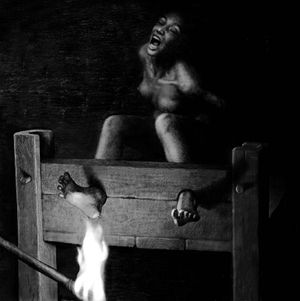Foot roasting
Foot roasting is a method of torture.
In one version of foot roasting, the prisoner was immobilized on his back and his bare feet were imprisoned in stocks of wood or iron. The soles of his feet were smeared with lard and slowly barbecued over red-hot coals. A bellows was used to control the intensity of the heat, while a screen could be interposed between the feet and the coals as questions were put; if the questions were not answered satisfactorily, the screen was withdrawn and the naked soles were exposed to the flames for an ever-increasing period of time. It is recorded in John Robinson's "Dungeon, Fire and Sword" (q.v.) that, when this torture was applied to the Knights Templar -- in an effort so determined and devoted that the order was essentially destroyed in a single night, which culminated in the torturous death of their leader, Jacques de Molay -- the burning was continued until the feet were charred to the bone: odd pieces of phalanges and metatarsals fell to the floor, here and there, and one particularly brave Templar was actually gifted a bag that contained pieces of bones that had fallen from his feet during the torture.
A more primitive form of this torture was employed in ancient Rome: flat plates of iron were heated red-hot and pressed to the soles of the feet. Something halfway between was employed in Brittany in the late Renaissance (from Geoffrey Abbott's Rack, Rope, and Red-Hot Pincers, q.v.) and consisted of a specially designed chair that incorporated both stocks to immobilize the naked feet and a tray of coals that could be raised and lowered by means of a crank. As the interrogation progressed, the coals were ever so slowly cranked closer to the feet, eventually making contact and grilling the flesh.
Knights Templar
Foot roasting was one of the principal tortures used to extract supposed confessions of heresy and other accusations made against the Knights Templar after their arrest in October 1307. It is recorded that one Templar's feet were so savagely tortured that—as he was being carried back to his cell—various pieces of charred bone fell from his feet to the floor. Prisoners could also be suspended head-downwards from stocks, with hot coals placed directly on the soles of the feet—held in place by gravity—while thin slivers of burning embers were slid between pairs of adjacent toes.
Roman Empire
The litany of ancient Roman tortures included the use of iron slippers, heated red-hot, into which a prisoners barefoot was thrust and which was left in place while the prisoner was forced to dance.
Brittany
In Brittany, an enhanced interrogation chair was used that immobilized the feet and provided a movable tray of coals that could be cranked up and down, eventually making physical contact with the soles of the feet.
Star kicking
A form of torture called "star kicking" supposedly began with Countess Elizabeth Bathory, who derived sadistic pleasure from placing oiled bits of paper or string between her prisoners’ toes and lighting the material on fire, inflicting savage burns. The name of the torture is presumably reflective of its victims' pathetic efforts to kick the offending material lose, showering the vicinity with sparks. As recently as 1982, five inmates in an Idaho jail tortured a younger boy in their cell for over four hours by winding toilet paper around and between his toes and setting it on fire, muffling his screams and hiding their activities when patrolling deputies walked past.
Chat rooms • What links here • Copyright info • Contact information • Category:Root
